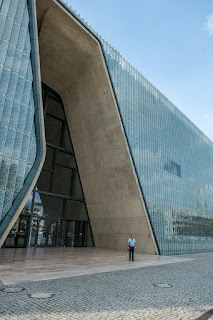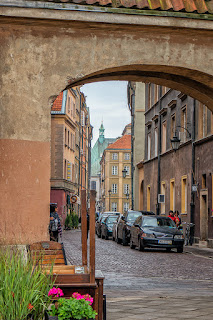Although I expected the Museum of the History of Polish Jews was going to be a somber visit, I wanted to have the experience. Poland is a country sandwiched between Germany and Russia and has been invaded, occupied, and ravaged by expansionist nations throughout its long history. Poles have known cruelty and deprivation on a scale few countries have. The Jews suffered more.

The museum is situated on a grassy square that was the heart of the ghetto in World War Two. I approached it from the east, and found the huge modern museum is overlooked by a 36-foot high, black monument. This commemorates the persecution of the Polish Jews and the uprising in 1943 of the Warsaw Ghetto. It looks like a wall and symbolizes both the ghetto walls and the Western Wall in Jerusalem. On the first side was a bas relief of such misery, one cannot but be moved. It signifies the persecution of the Jews by the Nazis in July, 1942.

On the far side of the monument that faces the museum, is a black sculpture of the Jewish insurgents who rose up to fight their oppressors in 1943. Men, women and children are shown with guns and Molotov cocktails. These are the Heroes of the Ghetto after whom the monument is named. The irony here is twofold: some of the stone used in building the sculpture was stockpiled by the Nazis for their own monuments, and the Russians erected it in 1948. This dominating feature of the site stands on the exact spot where the first clash took place in the uprising.

The museum beyond is a vast glass-cladded, ultra-modern structure, angular and sharp. Visitors are dwarfed by it (left). I tried to imagine what the ghetto looked like from where I stood at the entrance (below). I've read quite a lot about this period in Polish history but, because the site is surrounded by apartment buildings today, I simply couldn't.

The previous day I bought my ticket online for about $7.60 Canadian. This proved to be quite a bargain; so did the audio guide at $3.30. I had to pick an entrance time that prevents lineups and staggers the flow of visitors through the displays.
The museum opened in 2013 and inside is the complete opposite to the exterior. There is not a straight line or a sharp angle to be seen. The walls curve and swoop, sometimes oppressing and sometimes freeing; at times dark and at other moments filled with light.
The image, right, is the entrance hall and the stairs lead down to the exhibits. Security is a serious business here and visitors go through the same process as they do in airports — metal detectors, scanners, bag searches, etc.
Down I went and started at the beginning of the Polish Jews' 1000-year history.
Poland had 3.3 million Jews, the largest Jewish community in the world at the time of the Holocaust. Their ancient ancestors had arrived from western and southern European persecution along trade routes and found a safe place to settle here about 1000CE. By 1500, many lived in organized Jewish communities with laws that protected them and peace from the religious wars in the west. This was their golden age in the Polish-Lithuanian Commonwealth. It lasted until 1648.
The exhibits change from the medieval and later eras to exploring the Jewish way of life and the 18th century of learning and spiritual quest. They also explore the rise of anti-semitism in the Russian Empire. By WW1, a third of the Jewish population had emigrated, most to the USA.
The First World War left Germany and Russia in tatters and the Polish Jews enjoyed a second golden age. We see that cultural shift in politics and the arts, as well as daily life. It was brief.
The Nazis and then the Soviets invaded Poland early in WW2. This section of the museum focuses on how the Polish Jews experienced the myriad laws that separated and isolated them from their countrymen and women into ghettos — 600 across the nation. In 1942 the Nazis began to deport the Jews to Treblinka. In two months, 300,000 were transported from the Warsaw ghetto to their deaths. This exhibit is hard to see and I noticed several visitors in tears. Of 3.3 million Jews before the war, only about 300,000 remained in Poland, now a Communist state.
Many left for the new state of Israel. Those who stayed faced a Soviet anti-Semitic campaign in 1968 that all but eliminated the intellectuals and experts — they too emigrated.
Since the collapse of Communism in 1989, there has been a small renewal of Jewish life and this new museum has been part of it.
The exhibits put faces and names to the events in Poland for me. They tell the stories of real lives: the Jews' resilience and hope, the darkness they endured and despair. Reading took me part way there, but the excellent archival material and artefacts brought me to a whole new level of understanding.
I highly recommend putting a visit to the POLIN at the top of your list if you visit Warsaw. It was an amazing experience — so brilliantly done in every way.
The light shines in:
IMAGES:
© Photos by Pharos
All rights reserved























